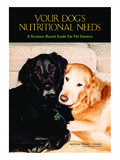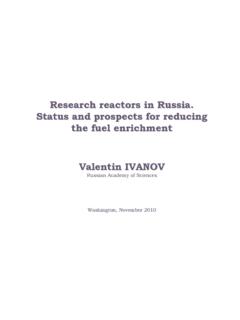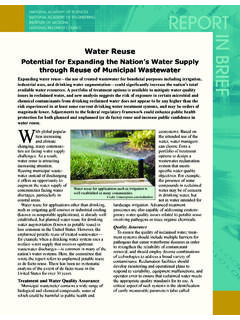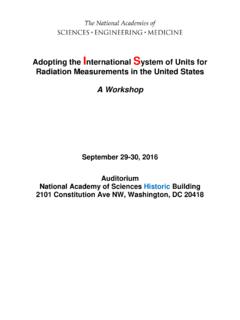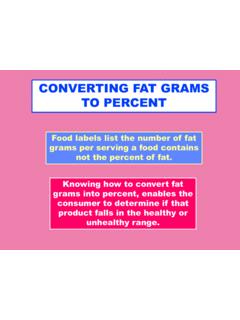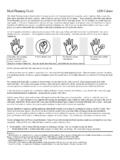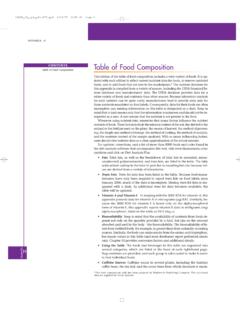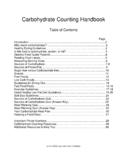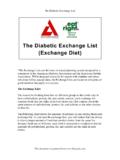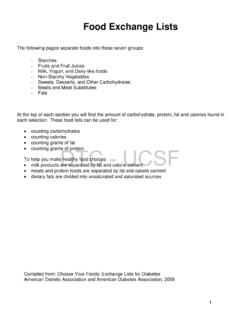Transcription of Your Cat's Nutritional Needs
1 YOUR CAT SNUTRITIONAL NEEDSA Science-Based Guide For Pet Owners37491_Cat_P01_16 07/24/06 4:53 PM Page 1 Storage and ProcessingThe stomach acts as a temporary storage and processingfacility before emptying its contents into the small intes-tine. Early stages of digestion take place in the stomach,where pepsin and lipase aid in digesting protein and DIGESTIVE TRACTCOMMITTEE ON NUTRIENT REQUIREMENTS OF DOGS AND CATSDONALD C. BEITZ, Chair, Iowa State University JOHN E. BAUER, Texas A&M University KEITH C. BEHNKE, Kansas State University DAVID A. DZANIS, Dzanis Consulting & Collaborations GEORGE C. FAHEY, University Of Illinois RICHARD C. HILL, University Of Florida FRANCIS A. KALLFELZ, Cornell University ELLEN KIENZLE, Zentrum F r Lebensmittel Und Tierern hrung, Oberschleissheim, Germany JAMES G. MORRIS, University Of California, Davis QUINTON R.
2 ROGERS, University Of California, DavisSupport for the development of this pamphlet was provided by the President s Circle CommunicationsInitiative of the National Academies. The pamphlet was written by Dale Feuer based on a report by theCommittee on Nutrient Requirements of Dogs and Cats. Illustration and design by Van of Nutrient Requirements of Dogs and Catsare available from the National Academies Press,500 Fifth Street, NW, Washington, DC, 20001; 800-624-6242 or 202-334-3313 (in the Washington area); 2006 by the National Academy of Sciences. All rights of DepartureThe mechanical breakdown of food begins in themouth, where food is ingested, chewed, and swal-lowed. Chemical breakdown starts here as well,with the secretion of enzyme-laden TransportThe esophagus is a short, musculartube in which involuntary, wavelikecontractions and relaxations propelfood from the mouth to the FacilitiesIn the small intestine, enzymes break down large, complex food mole-cules into simpler units that can be absorbed into the pancreas is an organ that does double duty secreting digestiveenzymes into the gut and hormones, including insulin and glucogon,into the blood.
3 Important for fat metabolism, the liver produces bileand partially stores it in the gall bladder between of the LineThe primary function of the largeintestine is to absorb electrolytes andwater. Also, this is where microbesferment nutrients that have so farescaped digestion and 07/24/06 4:53 PM Page 21 CONTENTSI ntroduction1 Proteins and Amino Acids2 Fats and Fatty Acids3 Energy Needs4 Vitamins6 Minerals8 Feeding Practices10 food Choices12 INTRODUCTIONHow much should I feed my cat? Does the food I m providing meet my cat snutritional Needs ? As our knowledge of the relationship between diet andhealth continues to advance and as the range of foods available for cats con-tinues to expand, it s more important than ever to base feeding choices ongood information. The information in this pamphlet is based on Nutrient Requirements of Dogsand Cats, a technical report issued by the National Research Council as partof its Animal Nutrition Series.
4 The food and Drug Administration relies oninformation in the report to regulate and ensure the safety of pet foods. Otherreports in the series address the Nutritional Needs of horses, dairy cattle, beefcattle, nonhuman primates, swine, poultry, fish, and small who study the Nutritional Needs of animals use the Animal NutritionSeries to guide future research. The series is also used by animal owners,caretakers, and veterinarians to develop specialized diets for individual ani-mals. Links to reports in the series can be found at 37491_Cat_P01_16x1 07/26/06 5:27 PM Page 12 Cats need several different kinds of nutrients to survive:amino acidsfrom protein, fatty acids and carbohydrates, vitamins, minerals, tables in this pamphlet provide recommended dailyallowances for nutrients based on the amount required to maintaingood health in normal cats.
5 Your cat s unique Nutritional requirementswill depend on its size and its stage in life, among other factors. A better under-standing of how cats use the various nutrients in food and how much of themthey need can help you choose a healthy diet for your AND AMINO ACIDSAs carnivorous animals, cats derive most of their protein from meat, fish,and other animal products. Some animal-based protein is easier todigest than plant-based protein and is better suited to the cat sdigestive system. Dietary protein contains 10 specific amino acids thatneither cats nor dogs can make on their as essential amino acids, they provide thebuilding blocks for many important biologicallyactive compounds and proteins. In addition,they provide the carbon chains needed tomake glucose for energy.
6 High-quality pro-teins have a good balance of all of theessential amino of single essential aminoacids can lead to serious health , for example, is critical to theremoval of ammonia from the bodythrough urine. Without sufficient argininein the diet, cats may suffer from a toxicbuildup of ammonia in the not the case for dogs, the aminoacid taurine is a dietary essential for deficiency in cats causes a host of meta-bolic and clinical problems, including feline centralretinal degeneration and blindness, deafness, car-diomyopathy and heart failure, inadequate immuneresponse, poor neonatal growth, reproductive failure, andcongenital defects. Found abundantly in many fish, birds, andsmall rodents, taurine is either absent or present only in traceamounts in plants.
7 Strict vegetarian diets are not appropriate for catsunless supplemented with nutrients essential for cats that are not found in 07/24/06 4:53 PM Page 23 FATS AND FATTY ACIDSD ietary fats, mainly derived from animal fats and the seed oils of various plants,provide the most concentrated source of energy in the diet. Fats contain more thantwice as much energy as protein and carbohydrates per gram . Dietary fats supplyessential fatty acids that cannot be synthesized in the body and serve as carriersfor important fat-soluble vitamins. Fatty acids play an important role in cell struc-ture and function. Additionally, food fats tend to enhance the taste and texture ofa cat s maximum amount of fat in the cat s diet can be reasonably high without anyknown adverse effects. In many cat foods, 50% or more of the energy comes fromfat.
8 Studies indicate that cat foods containing even higher amounts of fat are a minimum, cat foods should have a fat content of about 9% of dry fatty acids are necessary to keep your cat s skin and coat healthy. Deficienciesin the so-called omega-3 family of essential fatty acids can lead to a host abnor-malities of the nervous system, ranging from vision problems to impaired learningability. Another family of essential fatty acids, known as omega-6, has been shownto have important physiological effects in the body. Tissues that perform such func-tions as storage (fat), metabolism (liver), mechanical work (muscle), and excretion(kidney) tend to have cell membranes in which omega-6 fatty acids RECOMMENDED ALLOWANCES FOR PROTEIN AND FATSKITTENSADULT CATNURSING CATSW eighing lbWeighing 9 lb,Weighing 9 lb with 4 kittensconsuming 250 CaloriesCrude Protein10 g41 gTotal Fat4 g12 gDetermining Grams of Essential Nutrients from Petfood LabelsPetfood labels do not generally list amounts of essential nutrients in , all pet food labels must state guarantees for the minimum percentages ofcrude* protein and crude fat, and the maximum percentages of crude fiber andmoisture.
9 To convert these percentages to grams, simply multiply the crude per-centages times the weight of your cat s daily portion. For example, if you feed yourcat one 6-oz (170- gram ) can of food per day, and the food contains 8% crude pro-tein, the grams of protein would be x 170 = grams.* Crude refers to the specific method of testing the product, not to the quality of the nutrient itself. 37491_Cat_P01_16x1 07/26/06 5:28 PM Page 34 ENERGY NEEDSCats need a certain amount of energy to sustain the normal activities of their dailylives. Growth, pregnancy, lactation, and exercise all increase these normal ener-gy requirements. Generally measured in terms of calories, energy comes fromthree major dietary components: carbohydrates, protein, and not essential in the diet, carbohydrates provide an abundant source of ener-gy.
10 The major sources of carbohydrates in commercial cat foods are cereals,legumes, and other plant foodstuffs. Because cats are carnivores, the shortlength of their long intestines limits their ability to ferment fibers that are found inmany illness or trauma may increase a cat s energy Needs . Whenever your catbecomes ill, please consult with your veterinarian or cat nutritionist about yourcat s changed Nutritional 07/24/06 4:53 PM Page 45 ENERGY Needs OF KITTENSB efore weaning, kittens need 20 25 Calories for every 100 gramsof body weight. Cat owners should start supplemental feed-ings from to 4 weeks after birth, because mother s milkis no longer sufficient. ENERGY Needs OF PREGNANT ANDLACTATING CATSNew mothers typically suckle their kittens for 7 to 9weeks and will lose weight while nursing no matterwhat you feed them.


